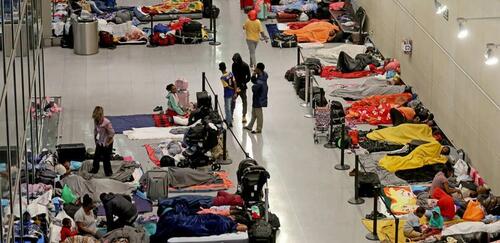Migrant Shelter Costs In Massachusetts To Exceed $1 Billion For The Next Several Years, State Predicts
By American Military News
Gov. Maura Healey’s administration expects to spend more money than originally anticipated over the next fiscal year on the emergency shelter system housing migrants and local families, according to revised estimates released this month.

Shelter-related costs are now projected to top $1 billion in fiscal year 2025 if caseloads remain the same, an increase from the $915 million state budget writers first said they expected to spend and a sign that officials do not forecast a slowdown in demand.
The numbers were included in a Monday report released only hours after Healey signed into law a state budget that includes $325 million for the shelter system and relies on $175 million in one-time dollars from the pandemic to pay down costs.
Spending is not expected to slow down after fiscal 2025 and top Democrats on Beacon Hill have previously acknowledged a likely need to allocate more taxpayer dollars to the shelter network.
In a presentation this month to a state commission, officials with the Healey administration said Massachusetts taxpayers will most likely need to shell out more than $1 billion in fiscal years 2026 and 2027 if the number of people seeking state-funded shelter services does not subside.
Sen. Ryan Fattman, a Sutton Republican who sits on the commission, said Massachusetts lawmakers and the commission should consider making permanent changes to the shelter system to keep it viable for residents.
“We can’t be seen as a state where, whether you’re from South Dakota or South America or anywhere in between, you just get to come and we’re going to take care of you,” he told the Herald in an interview Tuesday.
“A society can’t work that way. There has to be rules of the road and we’ve had very few in this program, which has become an albatross financially.”
The projections for fiscal year 2025 were revised in mid-July based on the assumption that the shelter system will remain at its 7,500-family cap moving forward, four overflow shelters stay open, and the “same level and supports from FY24” continue.
The original estimate of $915 million did not fully account for the operation of the four overflow sites, according to the Executive Office of Administration and Finance.
A spokesperson for the budget-writing office said the Healey administration “has been clear that the current size of the emergency assistance shelter system is unsustainable – both in terms of physical space and financially.”
“This is why the administration recently introduced a new prioritization policy and a five-day stay limit at temporary respite centers, in addition to implementing the nine-month length-of-stay limit in EA shelters,” the spokesperson said in a statement to the Herald.
The lion’s share of spending this fiscal year is expected to come in the “shelter and associated services” category, with more than $775 million likely to be shuttled to providers, according to the presentation.
Healey’s administration anticipates spending another $76 million on overflow shelters, $48 million on school and municipal supports, $44 million on intake and clinical assessment sites, and $25 million on work authorization and workforce initiatives, the presentation said.
But officials said legislators have not appropriated enough money to cover costs in fiscal year 2025 and dollars are expected to dry up on Jan. 1, 2025, if a $470 million spending gap is not closed, according to the presentation.
About half of the dollars necessary to cover spending in fiscal year 2025 have already been appropriated but administration officials said they will need to tap the rest of an account filled with leftover pandemic-era dollars that can only be used once.
“Our proposal to use (pandemic-era) funding to cover the remaining FY25 costs is a responsible strategy to address the needs of the system without impacting other critical programs,” the spokesperson for Healey’s budget-writing office said.
A push to allow Healey to access more pandemic-era funds could come later this year, but would likely face Republican resistance during a time in the legislative calendar when formal sessions are no longer held and any one lawmaker can block an advancing bill.
If pandemic-era dollars are not made available, Healey officials warned they will need to implement a “structured caseload reduction in direct shelter,” reduce or end overflow shelters, and curtail or end additional services, according to the presentation.
The governor has already put in place a range of measures intended to curb shelter demand.
Families with children and pregnant women, including migrants, can only stay at overflow shelters for five days before they are kicked out — a sharp change from the month-long time limit they were previously offered — and must wait six months before accessing the larger system.
State officials are also now prioritizing Massachusetts families who are homeless because of a no-fault eviction or because of a “sudden or unusual circumstances” beyond their control like a flood or fire, or if they have at least one family member who is a veteran.
The move came after Healey limited stays in the shelter system to nine months with several options for extensions.
Updated estimates from the state come as the Massachusetts Fiscal Alliance, a conservative group, warned that shelter costs could become a “fiscal time bomb” once temporary pandemic-era dollars run out.
“Massachusetts cannot continue to fund the world’s illegal and inadmissible migrants. We simply do not have the capability or the funds,” the group’s spokesman, Paul Craney, said in a statement. “Healey needs to pass into law that the state’s right to shelter law gives preference to Massachusetts residents first. She recently took steps to add this policy but it needs to become the law going forward.”
Spending on emergency shelters ballooned starting last year when a system that has historically housed around 4,000 families soon came to care for 7,500, according to official statistics.
Massachusetts’ housing and health agencies turned to a sprawling network of hotels, private organizations, National Guardsmen, resettlement agencies, and state buildings to house and provide services to local families and migrants.
Healey’s administration spent $793 million on the shelter network as of mid-June and the number is expected to grow as budget writers process invoices for the rest of fiscal year 2024. Officials estimate spending in the last fiscal year could reach $932 million.
Rep. Paul Frost, an Auburn Republican who is a part of the shelter commission, said he was not surprised to learn that costs are expected to exceed $1 billion this fiscal year.
“It’s not shocking. I mean, when they wouldn’t address the issue of the influx into the system from out-of-state applicants back in the fall, you have to expect this was going to happen,” he said.
Tyler Durden
Thu, 08/01/2024 – 09:40

 1 rok temu
1 rok temu














